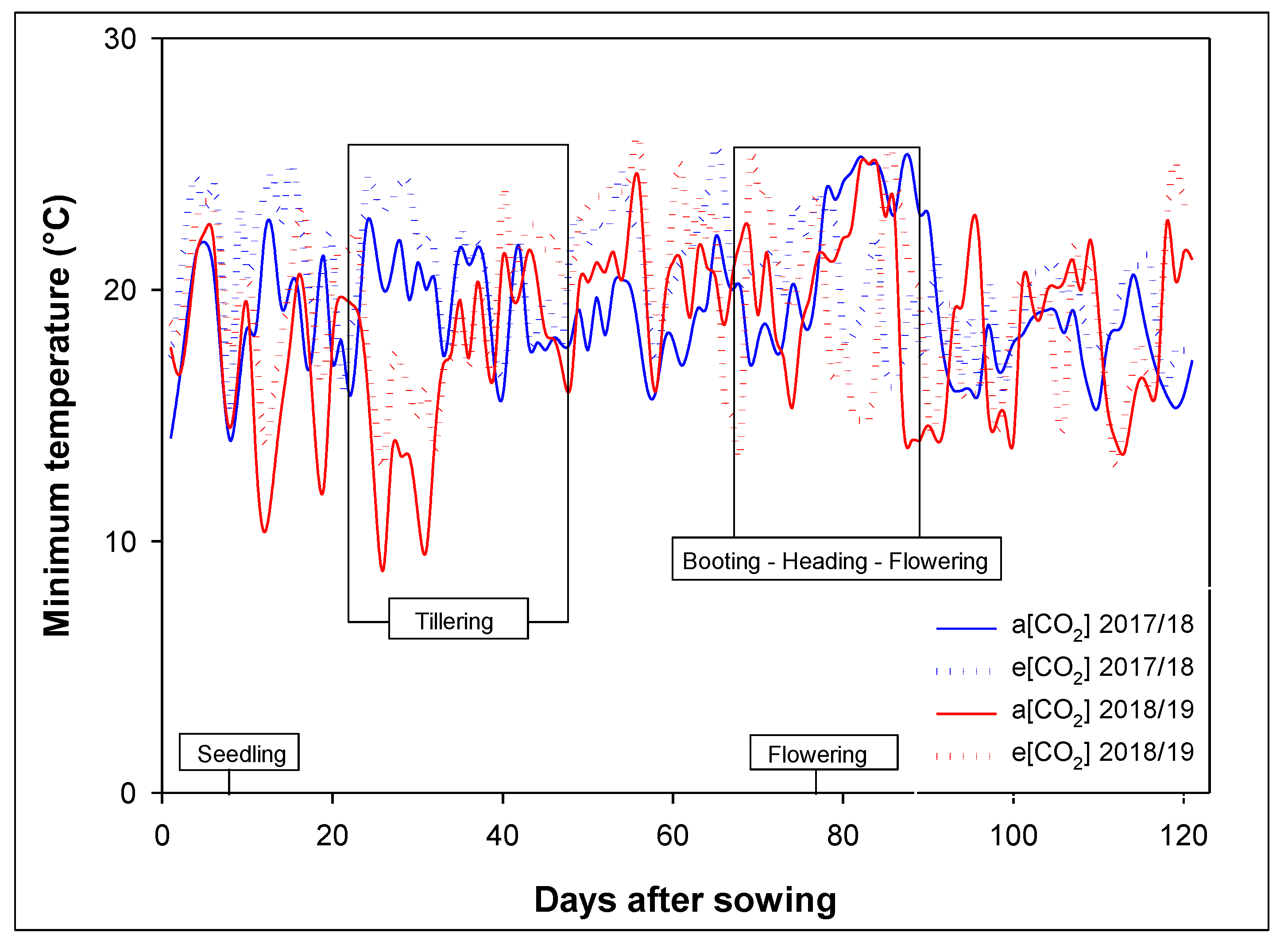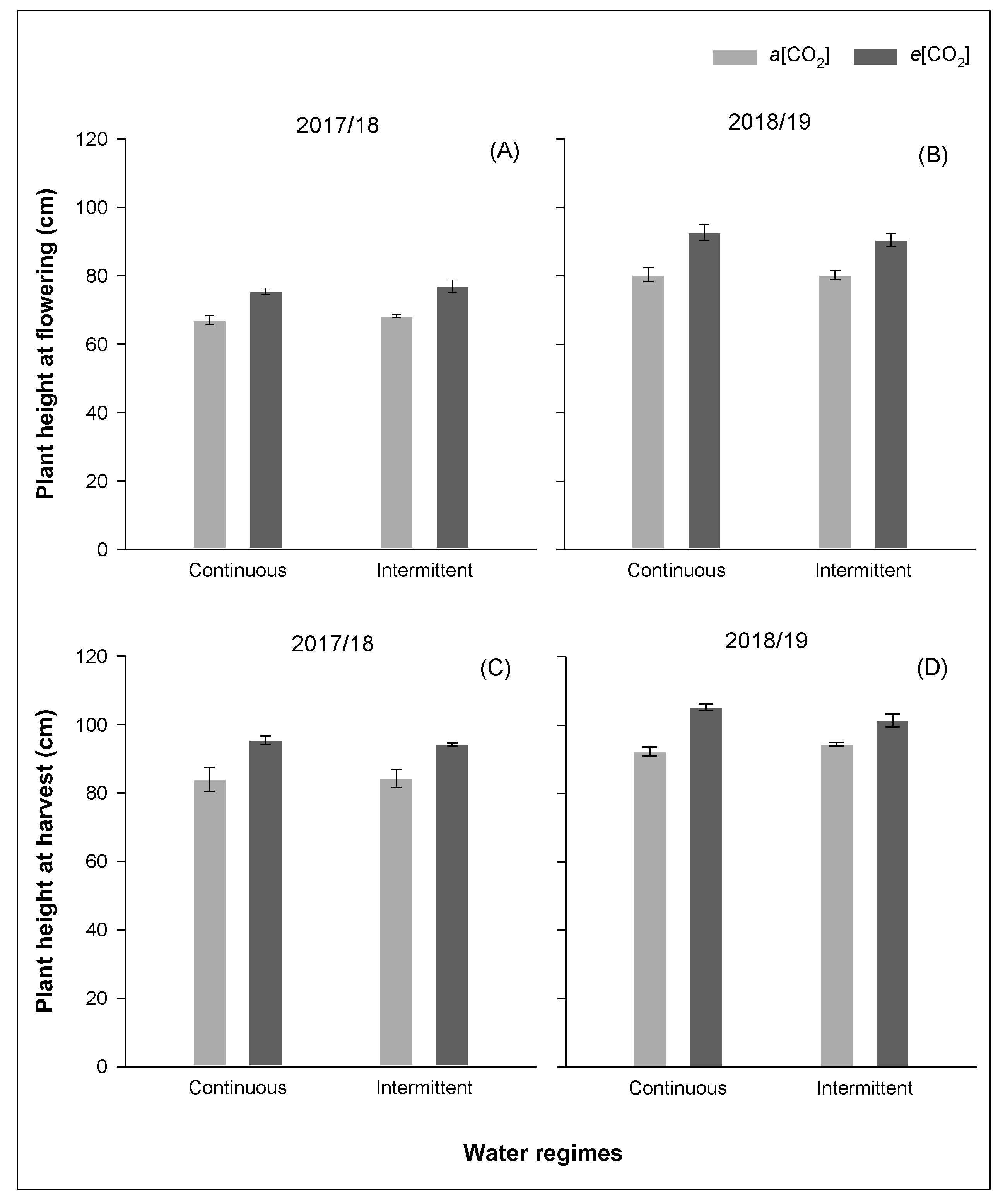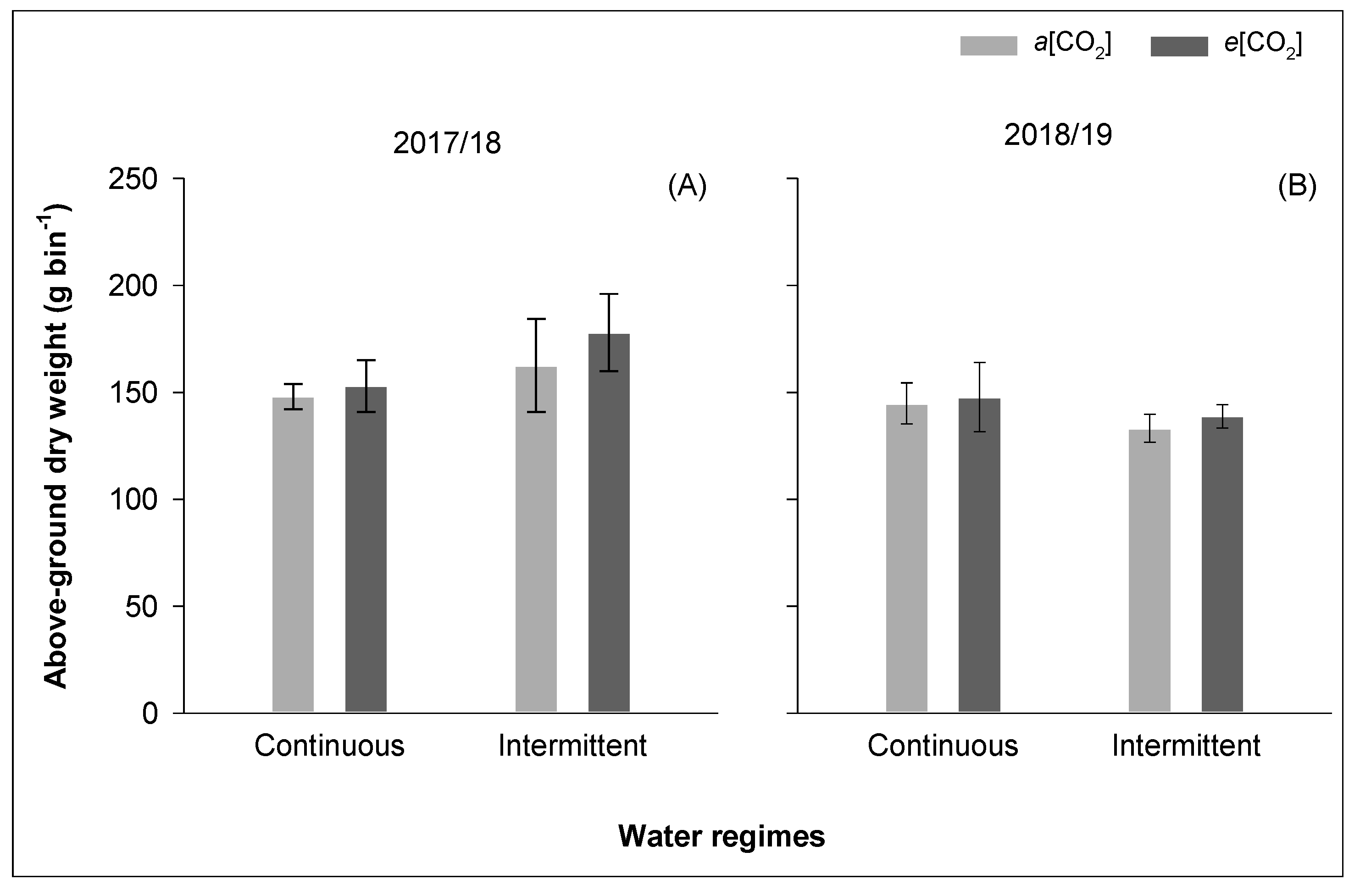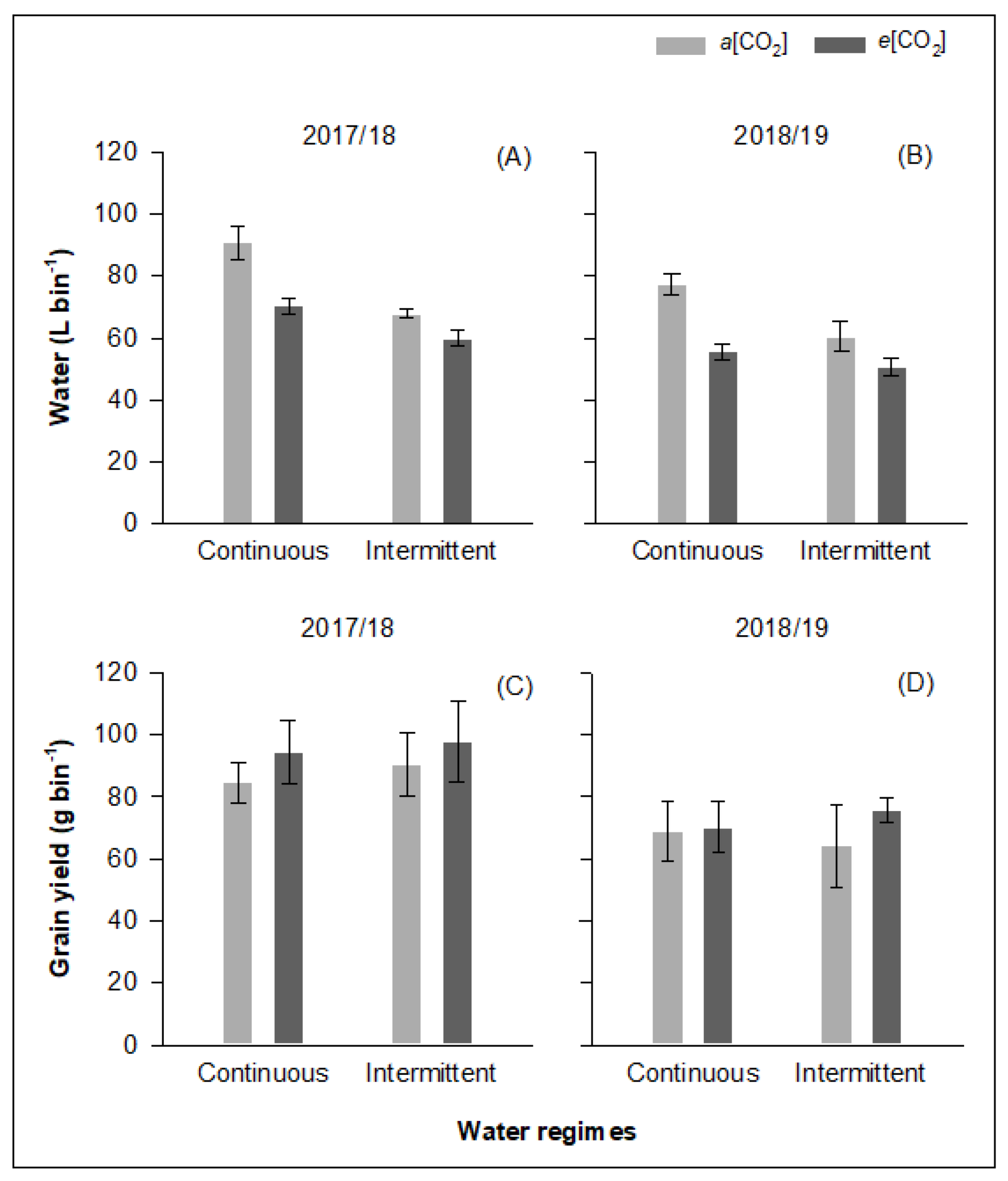Effects of Elevated Atmospheric CO2 Concentration and Water Regime on Rice Yield, Water Use Efficiency, and Arsenic and Cadmium Accumulation in Grain
Abstract
:1. Introduction
2. Materials and Methods
2.1. Experimental Conditions
2.2. Variables Analyzed
Determination of Arsenic and Cadmium in Rice Grain
2.3. Statistical Analysis
3. Results and Discussion
4. Conclusions
Author Contributions
Funding
Conflicts of Interest
References
- Chauan, B.S.; Jabran, K.; Mahajan, G. Rice Production Worldwide; Springer: Berlin/Heidelberg, Germany, 2017. [Google Scholar]
- Ram, P.C.; Maclean, J.L.; Dawe, D.C.; Hardy, B.; Hettel, G.P. Rice Almanac. Ann. Bot. 2003, 92, 739. [Google Scholar] [CrossRef] [Green Version]
- Singh, V.; Zhou, S.; Ganie, Z.; Valverde, B.; Avila, L.; Marchesan, E.; Merotto, A.; Zorrilla, G.; Burgos, N.; Norsworthy, J.; et al. Rice Production in the Americas. Rice Product. Worldw. 2017, 137–168. [Google Scholar] [CrossRef]
- Rosenzweig, C.; Elliott, J.; Deryng, D.; Ruane, A.C.; Müller, C.; Arneth, A.; Boote, K.; Folberth, C.; Glotter, M.; Khabarov, N.; et al. Assessing agricultural risks of climate change in the 21st century in a global gridded crop model intercomparison. Proc. Natl. Acad. Sci. USA 2014, 111, 3268–3273. [Google Scholar] [CrossRef] [Green Version]
- Wei, T.; Zhang, T.; Cui, X.; Glomsrød, S.; Liu, Y. Potential Influence of Climate Change on Grain Self-Sufficiency at the Country Level Considering Adaptation Measures. Earth’s Future 2019, 7, 1152–1166. [Google Scholar] [CrossRef] [Green Version]
- IPCC. Synthesis Report. Contribution of Working Groups I, II and III to the Fifth Assessment Report of the Intergovernmental Panel on Climate Change. In Climate Change; Pachauri, R.T., Meyer, L.A., Eds.; IPCC: Geneva, Switzerland, 2014; p. 151. [Google Scholar]
- Campbell, B.M.; Vermeulen, S.J.; Aggarwal, P.K.; Corner-Dolloff, C.; Girvetz, E.; Loboguerrero, A.M.; Ramirez-Villegas, J.; Rosenstock, T.; Sebastian, L.; Thornton, P.K.; et al. Reducing risks to food security from climate change. Glob. Food Secur. 2016, 11, 34–43. [Google Scholar] [CrossRef] [Green Version]
- Pareek, A.; Dhankher, O.P.; Foyer, C.H. Mitigating the impact of climate change on plant productivity and ecosystem sustainability. J. Exp. Bot. 2020, 71, 451–456. [Google Scholar] [CrossRef] [PubMed]
- Bocchiola, D. Impact of potential climate change on crop yield and water footprint of rice in the Po valley of Italy. Agric. Syst. 2015, 139, 223–237. [Google Scholar] [CrossRef]
- Thanawong, K.; Perret, S.; Basset-Mens, C. Eco-efficiency of paddy rice production in Northeastern Thailand: A comparison of rain-fed and irrigated cropping systems. J. Clean. Prod. 2014, 73, 204–217. [Google Scholar] [CrossRef]
- Jabran, K.; Chauhan, B. Weed management in aerobic rice systems. Crop. Prot. 2015, 78, 151–163. [Google Scholar] [CrossRef]
- Avila, L.; Marchezan, M.; Francois, T.; Cezimbra, D.; Souto, K.; Refatti, J. Toxicidade da mistura formulada de imazethapyr e imazapic sobre o azevém em função do teor de umidade do solo. Planta Daninha 2010, 28, 1041–1046. [Google Scholar] [CrossRef] [Green Version]
- Da Silva, L.S.; De Sousa, R.O.; Bohnen, H. Alterações no teores de nutrientes em dois solos alagados, com e sem plantas de arroz. Ciência Rural 2003, 33, 487–490. [Google Scholar] [CrossRef]
- Martínez-Eixarch, M.; Ellis, R.H. Temporal Sensitivities of Rice Seed Development from Spikelet Fertility to Viable Mature Seed to Extreme-Temperature. Corp Sci. 2015, 55, 354–364. [Google Scholar] [CrossRef] [Green Version]
- De Avila, L.A.; Martini, L.F.D.; Mezzomo, R.F.; Refatti, J.P.; Campos, R.; Cezimbra, D.M.; Machado, S.L.O.; Massey, J.H.; Carlesso, R.; Marchesan, E. Rice Water Use Efficiency and Yield under Continuous and Intermittent Irrigation. Agron. J. 2015, 107, 442–448. [Google Scholar] [CrossRef]
- Lampayan, R.M.; Rejesus, R.M.; Singleton, G.; Bouman, B.A. Adoption and economics of alternate wetting and drying water management for irrigated lowland rice. Field Corps Res. 2015, 170, 95–108. [Google Scholar] [CrossRef]
- Bouman, B.; Tuong, T. Field water management to save water and increase its productivity in irrigated lowland rice. Agric. Water Manag. 2001, 49, 11–30. [Google Scholar] [CrossRef]
- Massey, J.; Walker, T.W.; Anders, M.M.; Smith, M.C.; Avila, L. Farmer adaptation of intermittent flooding using multiple-inlet rice irrigation in Mississippi. Agric. Water Manag. 2014, 146, 297–304. [Google Scholar] [CrossRef]
- Carrijo, D.; Lundy, M.E.; Linquist, B.A. Rice yields and water use under alternate wetting and drying irrigation: A meta-analysis. Field Corps Res. 2017, 203, 173–180. [Google Scholar] [CrossRef]
- Levidow, L.; Zaccaria, D.; Maia, R.; Vivas, E.; Todorovic, M.; Scardigno, A. Improving water-efficient irrigation: Prospects and difficulties of innovative practices. Agric. Water Manag. 2014, 146, 84–94. [Google Scholar] [CrossRef] [Green Version]
- Ziska, L.H.; Bunce, J.A. Plant Responses to Rising Atmospheric Carbon Dioxide. Plant Growth Clim. Chang. 2007, 17–47. [Google Scholar] [CrossRef]
- Wu, J.; Kronzucker, H.J.; Shi, W. Dynamic analysis of the impact of free-air CO2 enrichment (FACE) on biomass and N uptake in two contrasting genotypes of rice. Funct. Plant Biol. 2018, 45, 696–704. [Google Scholar] [CrossRef]
- Wang, W.; Cai, C.; He, J.; Gu, J.; Zhu, G.; Zhang, W.; Zhu, J.; Liu, G. Yield, dry matter distribution and photosynthetic characteristics of rice under elevated CO2 and increased temperature conditions. Field Corps Res. 2020, 248, 107605. [Google Scholar] [CrossRef]
- Terashima, I.; Yanagisawa, S.; Sakakibara, H. Plant Responses to CO2: Background and Perspectives. Plant Cell Physiol. 2014, 55, 237–240. [Google Scholar] [CrossRef]
- Chen, H.; Tang, Z.; Wang, P.; Zhao, F.-J. Geographical variations of cadmium and arsenic concentrations and arsenic speciation in Chinese rice. Environ. Pollut. 2018, 238, 482–490. [Google Scholar] [CrossRef]
- Kato, L.S.; Fernandes, E.A.D.N.; Raab, A.; Bacchi, M.A.; Feldmann, J. Arsenic and cadmium contents in Brazilian rice from different origins can vary more than two orders of magnitude. Food Chem. 2019, 286, 644–650. [Google Scholar] [CrossRef] [Green Version]
- Banerjee, M.; Banerjee, N.; Bhattacharjee, P.; Mondal, D.; Lythgoe, P.R.; Martínez, M.; Pan, J.; Polya, D.A.; Giri, A.K. High arsenic in rice is associated with elevated genotoxic effects in humans. Sci. Rep. 2013, 3, 2195. [Google Scholar] [CrossRef] [PubMed] [Green Version]
- Souza, J.; Carneiro, M.F.H.; Paulelli, A.C.C.; Grotto, D.; Magalhaes, A.M.; Barbosa, F.; Batista, B.L. Arsenic and Rice: Toxicity, metabolism, and food safety. Química Nova 2014, 38, 118–127. [Google Scholar] [CrossRef]
- Linquist, B.A.; Anders, M.M.; Adviento-Borbe, M.A.A.; Chaney, R.L.; Nalley, L.L.; Da Rosa, E.F.; Van Kessel, C. Reducing greenhouse gas emissions, water use, and grain arsenic levels in rice systems. Glob. Chang. Biol. 2015, 21, 407–417. [Google Scholar] [CrossRef]
- Nguyen-Sy, T.; Cheng, W.; Tawaraya, K.; Sugawara, K.; Kobayashi, K. Impacts of climatic and varietal changes on phenology and yield components in rice production in Shonai region of Yamagata Prefecture, Northeast Japan for 36 years. Plant Prod. Sci. 2019, 22, 382–394. [Google Scholar] [CrossRef] [Green Version]
- Zheng, H.; Cheng, T.; Yao, X.; Deng, X.; Tian, Y.; Cao, W.; Zhu, Y. Detection of rice phenology through time series analysis of ground-based spectral index data. Field Corps Res. 2016, 198, 131–139. [Google Scholar] [CrossRef]
- Li, Y.; Lam, S.K.; Han, X.; Feng, Y.; Lin, E.; Li, Y.; Hao, X. Effects of elevated CO2 on rice grain yield and yield components: Is non-flooded plastic film mulching better than traditional flooding? Eur. J. Agron. 2017, 85, 25–30. [Google Scholar] [CrossRef]
- Takatani, N.; Ito, T.; Kiba, T.; Mori, M.; Miyamoto, T.; Maeda, S.-I.; Omata, T. Effects of High CO2 on Growth and Metabolism of Arabidopsis Seedlings During Growth with a Constantly Limited Supply of Nitrogen. Plant Cell Physiol. 2014, 55, 281–292. [Google Scholar] [CrossRef] [PubMed] [Green Version]
- Leadley, P.W.; Drake, B.G. Open top chambers for exposing plant canopies to elevated CO2 concentration and for measuring net gas exchange. Vegetatio 1993, 104–105, 3–15. [Google Scholar] [CrossRef]
- Silveira, L.; Feijó, A.; Benetti, C.; Refatti, J.; Fipke, M.; Camargo, E.; Ziska, L.; Avila, L. Elevated CO2 Concentrations and Water Stress Affect the Ability of Italian Ryegrass to Remediate Herbicides and Enhance its Allelopathic Effect. Planta Daninha 2019, 37, 1–8. [Google Scholar] [CrossRef] [Green Version]
- SOSBAI—Sociedade Sul-Brasileira de arroz irrigado. Recomendações Técnicas Da Pesquisa Para o Sul Do Brasil; SOSBAI: Farroupilha, Brazil, 2018; 205p. [Google Scholar]
- Counce, P.A.; Keisling, T.C.; Mitchell, A.J. A Uniform, Objective, and Adaptive System for Expressing Rice Development. Corp Sci. 2000, 40, 436–443. [Google Scholar] [CrossRef] [Green Version]
- Cerveira, C.; Hermann, P.; Pereira, J.; Pozebon, D.; Mesko, M.; Moraes, D. Evaluation of microwave-assisted ultraviolet digestion method for rice and wheat for subsequent spectrometric determination of As, Cd, Hg and Pb. J. Food Compos. Anal. 2020, 92, 103585. [Google Scholar] [CrossRef]
- R Core Team. R: A Language and Enviroment for Statistical Computing. R Found. Stat. Comput. 2020. Available online: https://www.r-projetc.org (accessed on 23 March 2020).
- Ye, C.; Fukai, S.; Godwin, I.; Reinke, R.; Snell, P.; Schiller, J.; Basnayake, J. Cold tolerance in rice varieties at different growth stages. Corp Pasture Sci. 2009, 60, 328–338. [Google Scholar] [CrossRef]
- Ziska, L.H.; Namuco, O.; Moya, T.; Quilang, J. Growth and Yield Response of Field-Grown Tropical Rice to Increasing Carbon Dioxide and Air Temperature. Agron. J. 1997, 89, 45–53. [Google Scholar] [CrossRef]
- Sakai, H.; Tokida, T.; Usui, Y.; Nakamura, H.; Hasegawa, T. Yield responses to elevated CO2 concentration among Japanese rice cultivars released since 1882. Plant Prod. Sci. 2019, 22, 352–366. [Google Scholar] [CrossRef] [Green Version]
- Makino, A. Photosynthesis, Grain Yield, and Nitrogen Utilization in Rice and Wheat. Plant Physiol. 2011, 155, 125–129. [Google Scholar] [CrossRef] [Green Version]
- Sakai, H.; Yagi, K.; Kobayashi, K.; Kawashima, S. Rice carbon balance under elevated CO2. New Phytol. 2001, 150, 241–249. [Google Scholar] [CrossRef]
- Li, Z.Y.; Song, Z.G.; Fan, X.Y.; Du, Z.J. Effects of Elevated CO2 on Nutrient Element Uptakes and Root Morphology of Different Rice Varieties. Plant Nutr. Fertil. Sci. 2013, 19, 20–25. [Google Scholar]
- Roy, K.S.; Bhattacharyya, P.; Neogi, S.; Rao, K.; Adhya, T. Combined effect of elevated CO2 and temperature on dry matter production, net assimilation rate, C and N allocations in tropical rice (Oryza sativa L.). Field Corps Res. 2012, 139, 71–79. [Google Scholar] [CrossRef]
- Kumar, U.; Quick, W.P.; Barrios, M.; Cruz, P.C.S.; Dingkuhn, M. Atmospheric CO2 concentration effects on rice water use and biomass production. PLoS ONE 2017, 12, e0169706. [Google Scholar] [CrossRef] [Green Version]
- Wang, J.; Li, L.; Lam, S.K.; Zhang, X.; Liu, X.; Pan, G. Changes in nutrient uptake and utilization by rice under simulated climate change conditions: A 2-year experiment in a paddy field. Agric. For. Meteorol. 2018, 250–251, 202–208. [Google Scholar] [CrossRef]
- Ghadirnezhad, R.; Fallah, A. Temperature Effect on Yield and Yield Components of Different Rice Cultivars in Flowering Stage. Int. J. Agron. 2014, 2014, 1–4. [Google Scholar] [CrossRef]
- Farrell, T.; Fox, K.; Williams, R.; Fukai, S. Genotypic variation for cold tolerance during reproductive development in rice: Screening with cold air and cold water. Field Corps Res. 2006, 98, 178–194. [Google Scholar] [CrossRef]
- Kim, H.-Y.; Lim, S.-S.; Kwak, J.-H.; Lee, D.-S.; Lee, S.-M.; Ro, H.-M.; Choi, W.-J. Dry matter and nitrogen accumulation and partitioning in rice (Oryza sativa L.) exposed to experimental warming with elevated CO2. Plant Soil 2010, 342, 59–71. [Google Scholar] [CrossRef]
- Lin, W.; Ziska, L.H.; Namuco, O.S.; Bai, K. The interaction of high temperature and elevated CO2 on photosynthetic acclimation of single leaves of rice in situ. Physiol. Plant. 1997, 99, 178–184. [Google Scholar] [CrossRef]
- Xu, H.-H.; Liu, S.-J.; Song, S.-H.; Wang, R.-X.; Wang, W.-Q.; Song, S.-Q. Proteomics analysis reveals distinct involvement of embryo and endosperm proteins during seed germination in dormant and non-dormant rice seeds. Plant Physiol. Biochem. 2016, 103, 219–242. [Google Scholar] [CrossRef]
- Hatfield, J.L.; Dold, C. Water-Use Efficiency: Advances and Challenges in a Changing Climate. Front. Plant Sci. 2019, 10, 103. [Google Scholar] [CrossRef] [PubMed] [Green Version]
- Zhang, J.; Zhao, Q.-Z.; Duan, G.-L.; Huang, Y.-C. Influence of sulphur on arsenic accumulation and metabolism in rice seedlings. Environ. Exp. Bot. 2011, 72, 34–40. [Google Scholar] [CrossRef]
- Shri, M.; Kumar, S.; Chakrabarty, D.; Trivedi, P.K.; Mallick, S.; Misra, P.; Shukla, D.; Mishra, S.; Srivastava, S.; Tripathi, R.D.; et al. Effect of arsenic on growth, oxidative stress, and antioxidant system in rice seedlings. Ecotoxicol. Environ. Saf. 2009, 72, 1102–1110. [Google Scholar] [CrossRef] [PubMed]
- Atiaga, O.; Otero, X.L.; Gallego-Picó, A.; Escobar-Castañeda, L.; Bravo-Yagüe, J.; Carrera-Villacrés, D. Analysis of total arsenic content in purchased rice from Ecuador. Czech J. Food Sci. 2019, 37, 425–431. [Google Scholar] [CrossRef]
- Zhu, C.; Kobayashi, K.; Loladze, I.; Zhu, J.; Jiang, Q.; Xu, X.; Liu, G.; Seneweera, S.; Ebi, K.L.; Drewnowski, A.; et al. Carbon dioxide (CO2) levels this century will alter the protein, micronutrients, and vitamin content of rice grains with potential health consequences for the poorest rice-dependent countries. Sci. Adv. 2018, 4, eaaq1012. [Google Scholar] [CrossRef] [PubMed] [Green Version]
- Myers, S.S.; Zanobetti, A.; Kloog, I.; Huybers, P.; Leakey, A.; Bloom, A.J.; Carlisle, E.; Dietterich, L.H.; Fitzgerald, G.; Hasegawa, T.; et al. Increasing CO2 threatens human nutrition. Nat. Cell Biol. 2014, 510, 139–142. [Google Scholar] [CrossRef]
- Fernandez, V.; Barnaby, J.; Tomecek, M.; Codling, E.E.; Ziska, L.H. Elevated CO2 may reduce arsenic accumulation in diverse ecotypes of Arabidopsis thaliana. J. Plant Nutr. 2017, 41, 645–653. [Google Scholar] [CrossRef]
- Rahaman, S.; Sinha, A.C. Water regimes: An approach of mitigation arsenic in summer rice (Oryza sativa L.) under different topo sequences on arsenic-contaminated soils of Bengal delta. Paddy Water Environ. 2013, 11, 397–410. [Google Scholar] [CrossRef]
- Da Silva, J.T.; Paniz, F.P.; Sanchez, F.E.S.; Pedron, T.; Torres, D.P.; Concenço, F.I.G.D.R.; Parfitt, J.M.B.; Batista, B.L. Selected soil water tensions at phenological phases and mineral content of trace elements in rice grains—mitigating arsenic by water management. Agric. Water Manag. 2020, 228. [Google Scholar] [CrossRef]
- Zecchin, S.; Corsini, A.; Martin, M.; Cavalca, L. Influence of water management on the active root-associated microbiota involved in arsenic, iron, and sulfur cycles in rice paddies. Appl. Microbiol. Biotechnol. 2017, 101, 6725–6738. [Google Scholar] [CrossRef] [PubMed]
- ANVISA (Brazilian Health Regulatory Agency). Maximum Limits of Inorganic Contaminants in Food; ANVISA: Brasília, Brazil, 2013.







| Panicles (m2) | Grains per 10 Panicles | 1000-Grain Weight (g) | Spikelet Sterility (%) | |||||
|---|---|---|---|---|---|---|---|---|
| 2017/18 Season | ||||||||
| [CO2] | Irrigation water regime | |||||||
| CON a | INT b | CON | INT | CON | INT | CON | INT | |
| a[CO2] c | 523 ± 50 e ns | 520 ± 80 | 636 ± 66 ns | 732 ± 29 | 18 ± 1 ns | 18 ± 1 | 11 ± 1 ns | 11 ± 1 |
| e[CO2] d | 520 ± 82 | 522 ± 68 | 711 ± 36 | 731 ± 53 | 18 ± 1 | 18 ± 1 | 10 ± 3 | 10 ± 3 |
| CV(%) f | 21.34 | 39.86 | 13.54 | 19.71 | ||||
| 2018/19 Season | ||||||||
| a[CO2] | 580 ± 31 ns | 552 ± 26 | 581 ± 65 ns | 480 ± 143 | 17 ± 1 ns | 17 ± 1 | 32 ± 4 ns | 28 ± 2 |
| e[CO2] | 602 ± 37 | 574 ± 43 | 550 ± 136 | 649 ± 152 | 17 ± 1 | 18 ± 1 | 34 ± 9 | 31 ± 4 |
| CV(%) | 23.18 | 56.13 | 15.89 | 17.72 | ||||
Publisher’s Note: MDPI stays neutral with regard to jurisdictional claims in published maps and institutional affiliations. |
© 2021 by the authors. Licensee MDPI, Basel, Switzerland. This article is an open access article distributed under the terms and conditions of the Creative Commons Attribution (CC BY) license (https://creativecommons.org/licenses/by/4.0/).
Share and Cite
Balbinot, A.; da Rosa Feijó, A.; Fipke, M.V.; Rockenbach, D.; Massey, J.H.; Camargo, E.R.; Mesko, M.F.; Scaglioni, P.T.; de Avila, L.A. Effects of Elevated Atmospheric CO2 Concentration and Water Regime on Rice Yield, Water Use Efficiency, and Arsenic and Cadmium Accumulation in Grain. Agriculture 2021, 11, 705. https://doi.org/10.3390/agriculture11080705
Balbinot A, da Rosa Feijó A, Fipke MV, Rockenbach D, Massey JH, Camargo ER, Mesko MF, Scaglioni PT, de Avila LA. Effects of Elevated Atmospheric CO2 Concentration and Water Regime on Rice Yield, Water Use Efficiency, and Arsenic and Cadmium Accumulation in Grain. Agriculture. 2021; 11(8):705. https://doi.org/10.3390/agriculture11080705
Chicago/Turabian StyleBalbinot, Andrisa, Anderson da Rosa Feijó, Marcus Vinicius Fipke, Dalvane Rockenbach, Joseph Harry Massey, Edinalvo Rabaioli Camargo, Marcia Foster Mesko, Priscila Tessmer Scaglioni, and Luis Antonio de Avila. 2021. "Effects of Elevated Atmospheric CO2 Concentration and Water Regime on Rice Yield, Water Use Efficiency, and Arsenic and Cadmium Accumulation in Grain" Agriculture 11, no. 8: 705. https://doi.org/10.3390/agriculture11080705








